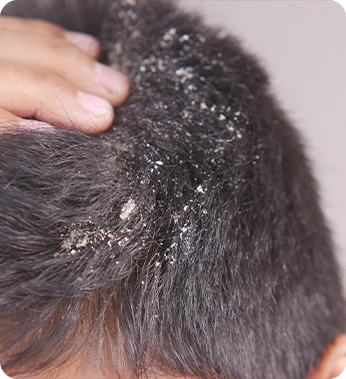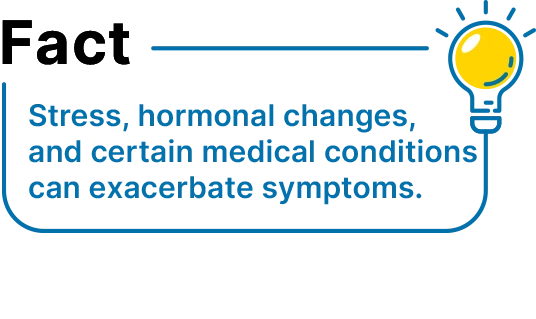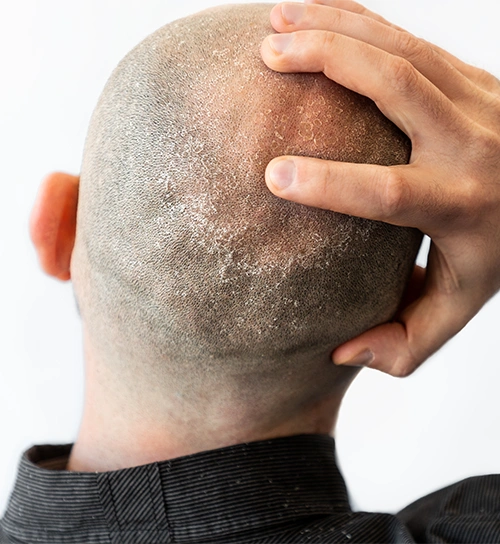Seborrheic Dermatitis - Causes, Symptoms & Effective Treatment
Get Expert Treatment for Seborrheic Dermatitis
Book your Appointment
Recent studies indicate that seborrheic dermatitis affects 1 in every 38 individuals approximately of the Indian population, underscoring its significant prevalence
At Dr Batra's®, we offer personalised homeopathic treatments that address the root causes of seborrheic dermatitis, providing long-term relief without side effects. Our holistic approach has benefited numerous patients, helping them achieve healthier scalps and improved quality of life
At Dr Batra's®, we offer a comprehensive approach to treating seborrheic dermatitis:
Personalised Assessments
Each patient undergoes an in-depth consultation and scalp analysis using advanced AI-powered diagnostics to develop a customised treatment plan
Homeopathy Combined with Advanced Aesthetics
Our treatments target the root cause for long-lasting relief, while aesthetic procedures promote visible scalp improvement in just six sessions
Holistic Treatment Approach
We complement homeopathy with dietary recommendations and lifestyle modifications to enhance scalp health naturally
Expertise & Proven Results
With over 40 years of experience, a team of 300+ doctors across 200+ clinics, and a success rate exceeding 90%, we have successfully treated over 150,000 patients globally
Regular Monitoring & Progress Tracking
Patients receive ongoing consultations and assessments with senior doctors to ensure optimal results and make necessary adjustments
Seborrheic Dermatitis is a chronic inflammatory skin condition that primarily affects the scalp, causing redness, flaking, itching, and dandruff-like scales. It is commonly seen in areas with high oil (sebum) production, such as the scalp, face, and chest
While not contagious, this condition can be persistent and recurrent, affecting confidence and scalp health. If left untreated, it may worsen over time, leading to irritation and hair loss

Seborrheic Dermatitis presents differently depending on severity:

Early diagnosis and personalised treatment help control symptoms effectively and prevent worsening
Seborrheic Dermatitis does not directly cause permanent hair loss, but severe inflammation and frequent scratching can:
Weaken hair follicles
Leading to temporary hair shedding
Increase scalp sensitivity
Affecting hair growth cycles
Cause excess oil buildup
Clogging hair follicles and delaying regrowth
The good news? With proper treatment, hair regrows once inflammation is controlled, preventing further damage.
The exact cause of seborrheic dermatitis isn’t fully understood, but multiple factors contribute to flare-ups:
Excess Sebum Production
Oily skin provides an ideal environment for yeast growth
Malassezia Yeast Overgrowth
This naturally occurring fungus can trigger inflammation
Weather Changes
Cold, dry climates or humid conditions worsen symptoms
Stress & Hormonal Imbalance
Stress triggers flare-ups and aggravates scalp irritation
Certain Hair Products
Harsh chemicals or excessive product buildup irritate the scalp
Underlying Medical Conditions
Seborrheic Dermatitis is more common in individuals with Parkinson's disease, weakened immunity, or hormonal imbalances
Identifying your triggers helps in managing and preventing future flare-ups.
Seborrheic Dermatitis symptoms vary but typically include:
Persistent Flaking
White or yellowish greasy scales resembling dandruff
Itchy Scalp
Constant itching can lead to further irritation
Redness & Inflammation
Especially along the hairline, behind ears, or on eyebrows
Oily or Greasy Scalp
Excessive oil buildup worsens the condition
Burning Sensation
Scalp discomfort or sensitivity
Seborrheic Dermatitis can affect anyone, but certain groups are at a higher risk:
People with oily skin or scalp
Excess sebum production increases susceptibility
Individuals with a family history
Genetics play a role in skin conditions
People with weakened immunity
Conditions like HIV/AIDS, diabetes, and neurological disorders increase risk
Infants (Cradle Cap)
A temporary form of seborrheic dermatitis in babies
Individuals under stress
Emotional stress can worsen flare-ups
Managing lifestyle and skincare habits can reduce the frequency and severity of symptoms.
Seborrheic Dermatitis is clinically diagnosed through:
Scalp Examination
A dermatologist checks for scaling, redness, and inflammation
Medical History Analysis
Identifying triggers and contributing factors
Skin Biopsy (If Necessary)
Rarely needed to rule out similar conditions like psoriasis or eczema
A proper diagnosis helps in selecting the most effective treatment.
The right treatment helps manage symptoms and prevent flare-ups. Common options include:
Homeopathy
A natural, side-effect-free approach that treats the condition inside out
Medicated Shampoos
Containing ketoconazole, zinc pyrithione, or salicylic acid
Topical Treatments
Corticosteroid creams or antifungal agents to reduce inflammation
Lifestyle Changes
Gentle scalp cleansing, stress reduction, and avoiding harsh hair products
Diet Modifications
Anti-inflammatory foods to help control symptoms
Homeopathy offers a natural, side-effect-free approach to treating seborrheic dermatitis from within!
Seborrheic dermatitis for the scalp is triggered by stress, hormonal changes, environmental factors, and medical conditions. Malassezia yeast overgrowth is a primary cause. Learn about seborrhoeic dermatitis causes and explore homeopathic treatment for seborrheic dermatitis for effective symptom relief and long-term scalp health.
Seborrheic dermatitis scalp may improve temporarily but often recurs without treatment. Consistent care, including homeopathic remedies for seborrheic dermatitis on scalp, is essential for managing symptoms and preventing frequent flare-ups.
Yes, Malassezia yeast overgrowth contributes to seborrheic dermatitis scalp, leading to irritation and flaking. Discover seborrhoeic dermatitis causes and effective homeopathic treatment for seborrheic dermatitis to reduce fungal impact and inflammation.
Sugary, processed foods may worsen seborrheic dermatitis for scalp symptoms. A balanced diet and homeopathic remedies for seborrheic dermatitis on scalp can help reduce flare-ups and maintain scalp health.
Wash hair regularly with gentle shampoo to manage seborrheic dermatitis scalp symptoms. Use homeopathic remedies for seborrheic dermatitis on scalp for natural relief and healthier scalp maintenance.
Seborrhoeic dermatitis symptoms include redness, greasy scales, and inflammation, unlike common dandruff. Compare atopic dermatitis vs seborrheic dermatitis for accurate diagnosis and treatment.
Yes, hair loss seborrheic dermatitis occurs due to scalp inflammation. Timely homeopathic treatment for seborrheic dermatitis helps reduce inflammation and promotes hair regrowth.
Hair loss seborrheic dermatitis happens when inflammation weakens follicles. With proper care, including homeopathic remedies for seborrheic dermatitis on scalp, hair regrowth is achievable.
Visible improvement in seborrheic dermatitis scalp symptoms occurs within weeks with consistent use of homeopathic treatment for seborrheic dermatitis and proper scalp care routines.
Prevent seborrheic dermatitis for scalp by managing stress, maintaining a scalp care routine, and avoiding triggers. Regular use of homeopathic remedies for seborrheic dermatitis on scalp helps prevent flare-ups.
Several homeopathic remedies may help manage seborrheic dermatitis on the scalp, depending on individual symptoms. Common options include:
Note: It is essential to consult a qualified homeopathic practitioner for personalised treatment.